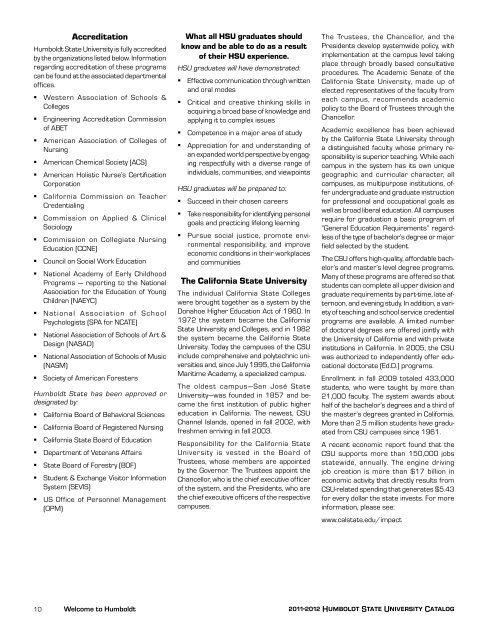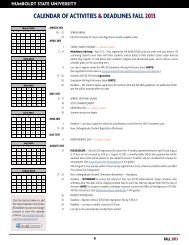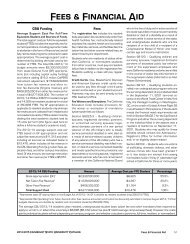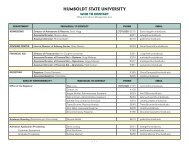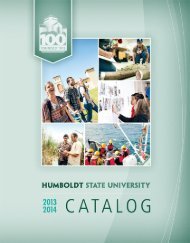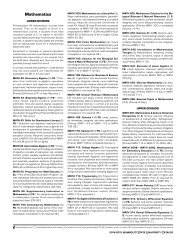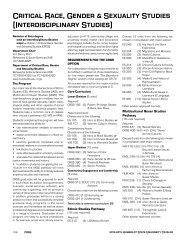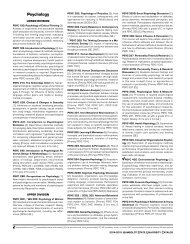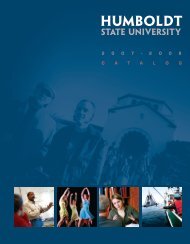2011-12 Academic Year - Bad Request - Humboldt State University
2011-12 Academic Year - Bad Request - Humboldt State University
2011-12 Academic Year - Bad Request - Humboldt State University
You also want an ePaper? Increase the reach of your titles
YUMPU automatically turns print PDFs into web optimized ePapers that Google loves.
Accreditation<br />
<strong>Humboldt</strong> <strong>State</strong> <strong>University</strong> is fully accredited<br />
by the organizations listed below. Information<br />
regarding accreditation of these programs<br />
can be found at the associated departmental<br />
offices.<br />
Western Association of Schools &<br />
Colleges<br />
Engineering Accreditation Commission<br />
of ABET<br />
American Association of Colleges of<br />
Nursing<br />
American Chemical Society (ACS)<br />
American Holistic Nurse’s Certification<br />
Corporation<br />
California Commission on Teacher<br />
Credentialing<br />
Commission on Applied & Clinical<br />
Sociology<br />
Commission on Collegiate Nursing<br />
Education (CCNE)<br />
Council on Social Work Education<br />
National Academy of Early Childhood<br />
Programs — reporting to the National<br />
Association for the Education of Young<br />
Children (NAEYC)<br />
National Association of School<br />
Psychologists (SPA for NCATE)<br />
National Association of Schools of Art &<br />
Design (NASAD)<br />
National Association of Schools of Music<br />
(NASM)<br />
Society of American Foresters<br />
<strong>Humboldt</strong> <strong>State</strong> has been approved or<br />
designated by:<br />
California Board of Behavioral Sciences<br />
California Board of Registered Nursing<br />
California <strong>State</strong> Board of Education<br />
Department of Veterans Affairs<br />
<strong>State</strong> Board of Forestry (BOF)<br />
Student & Exchange Visitor Information<br />
System (SEVIS)<br />
US Office of Personnel Management<br />
(OPM)<br />
What all HSU graduates should<br />
know and be able to do as a result<br />
of their HSU experience.<br />
HSU graduates will have demonstrated:<br />
Effective communication through written<br />
and oral modes<br />
Critical and creative thinking skills in<br />
acquiring a broad base of knowledge and<br />
applying it to complex issues<br />
Competence in a major area of study<br />
Appreciation for and understanding of<br />
an expanded world perspective by engaging<br />
respectfully with a diverse range of<br />
individuals, communities, and viewpoints<br />
HSU graduates will be prepared to:<br />
Succeed in their chosen careers<br />
Take responsibility for identifying personal<br />
goals and practicing lifelong learning<br />
Pursue social justice, promote environmental<br />
responsibility, and improve<br />
economic conditions in their workplaces<br />
and communities<br />
The California <strong>State</strong> <strong>University</strong><br />
The individual California <strong>State</strong> Colleges<br />
were brought together as a system by the<br />
Donahoe Higher Education Act of 1960. In<br />
1972 the system became the California<br />
<strong>State</strong> <strong>University</strong> and Colleges, and in 1982<br />
the system became the California <strong>State</strong><br />
<strong>University</strong>. Today the campuses of the CSU<br />
include comprehensive and polytechnic universities<br />
and, since July 1995, the California<br />
Maritime Academy, a specialized campus.<br />
The oldest campus—San José <strong>State</strong><br />
<strong>University</strong>—was founded in 1857 and became<br />
the first institution of public higher<br />
education in California. The newest, CSU<br />
Channel Islands, opened in fall 2002, with<br />
freshmen arriving in fall 2003.<br />
Responsibility for the California <strong>State</strong><br />
<strong>University</strong> is vested in the Board of<br />
Trustees, whose members are appointed<br />
by the Governor. The Trustees appoint the<br />
Chancellor, who is the chief executive officer<br />
of the system, and the Presidents, who are<br />
the chief executive officers of the respective<br />
campuses.<br />
The Trustees, the Chancellor, and the<br />
Presidents develop systemwide policy, with<br />
implementation at the campus level taking<br />
place through broadly based consultative<br />
procedures. The <strong>Academic</strong> Senate of the<br />
California <strong>State</strong> <strong>University</strong>, made up of<br />
elected representatives of the faculty from<br />
each campus, recommends academic<br />
policy to the Board of Trustees through the<br />
Chancellor.<br />
<strong>Academic</strong> excellence has been achieved<br />
by the California <strong>State</strong> <strong>University</strong> through<br />
a distinguished faculty whose primary responsibility<br />
is superior teaching. While each<br />
campus in the system has its own unique<br />
geographic and curricular character, all<br />
campuses, as multipurpose institutions, offer<br />
undergraduate and graduate instruction<br />
for professional and occupational goals as<br />
well as broad liberal education. All campuses<br />
require for graduation a basic program of<br />
“General Education Requirements” regardless<br />
of the type of bachelor’s degree or major<br />
field selected by the student.<br />
The CSU offers high-quality, affordable bachelor’s<br />
and master’s level degree programs.<br />
Many of these programs are offered so that<br />
students can complete all upper division and<br />
graduate requirements by part-time, late afternoon,<br />
and evening study. In addition, a variety<br />
of teaching and school service credential<br />
programs are available. A limited number<br />
of doctoral degrees are offered jointly with<br />
the <strong>University</strong> of California and with private<br />
institutions in California. In 2005, the CSU<br />
was authorized to independently offer educational<br />
doctorate (Ed.D.) programs.<br />
Enrollment in fall 2009 totaled 433,000<br />
students, who were taught by more than<br />
21,000 faculty. The system awards about<br />
half of the bachelor’s degrees and a third of<br />
the master’s degrees granted in California.<br />
More than 2.5 million students have graduated<br />
from CSU campuses since 1961.<br />
A recent economic report found that the<br />
CSU supports more than 150,000 jobs<br />
statewide, annually. The engine driving<br />
job creation is more than $17 billion in<br />
economic activity that directly results from<br />
CSU-related spending that generates $5.43<br />
for every dollar the state invests. For more<br />
information, please see:<br />
www.calstate.edu/impact<br />
10 Welcome to <strong>Humboldt</strong><br />
<strong>2011</strong>-20<strong>12</strong> <strong>Humboldt</strong> <strong>State</strong> <strong>University</strong> Catalog


